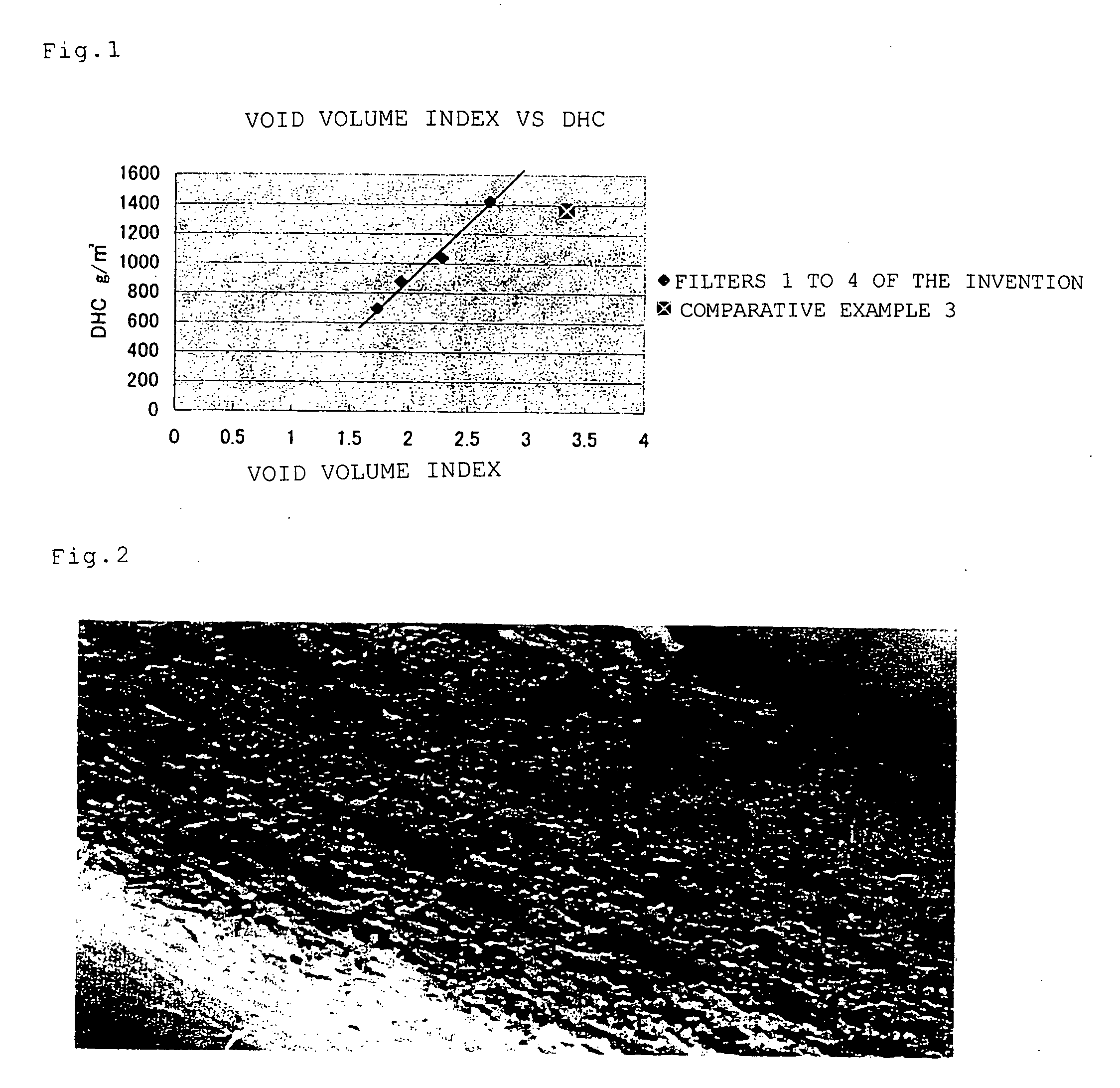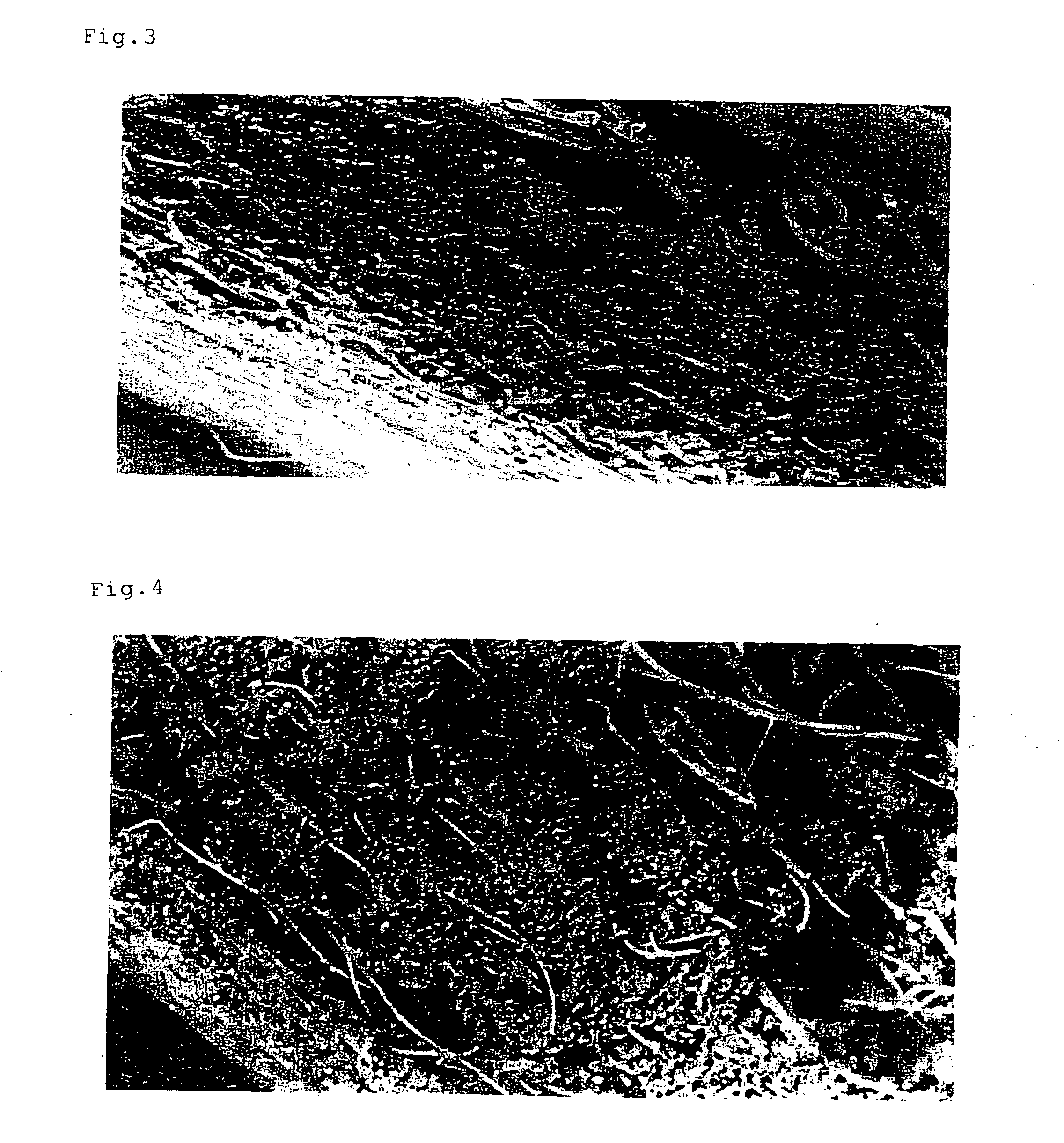Nonwoven fabric air filter for internal combustion engine
a technology of air filter and nonwoven fabric, which is applied in the direction of isotope separation, separation process, and dispersed particle separation, etc., can solve the problems of increasing pressure loss, reducing the collection efficiency of the filter, and requiring a large amount of heat energy for drying a wet nonwoven fabri
- Summary
- Abstract
- Description
- Claims
- Application Information
AI Technical Summary
Benefits of technology
Problems solved by technology
Method used
Image
Examples
example 1
[0079] Five-millimeter long polyester-based conjugated binder fibers composed of a core of polyethylene terephthalate and a sheath of phthalic acid-isophthalic acid / ethylene glycol copolymer having a melting point of 150° C. were blasted as raw material fibers from three blast portions positioned over a porous net conveyer to form fiber layers on the net conveyer while sucking with an air suction portion arranged under the net conveyer. At this time, the fiber layers were sequentially laminated so that large-fiber to fine-fiber layers were disposed from an upper layer side (fluid inflow side) to a lower layer side (fluid outflow side), and then, brought in a heat oven to bond the fibers by hot air, thereby preparing an integrated nonwoven fabric.
[0080] As the lower layer, the above-mentioned binder fibers of 2.2 dtex (diameter: 14.3 μm) were spun through a blast nozzle A so as to give a basis weight of 110 g / m2. Similarly, as the intermediate layer, the above-mentioned binder fiber...
example 2
[0082] Using five-millimeter long polyester fiber-based conjugated binder fibers composed of a core of polyethylene terephthalate and a sheath of phthalic acid-isophthalic acid / ethylene glycol copolymer having a melting point of 150° C. as raw material fibers, a heat-bonded nonwoven fabric was prepared in the same manner as with Example 1.
[0083] As the lower layer, intermediate layer and upper layer, the binder fibers of 1.5 dtex (diameter: 11.8 μm), 2.2 dtex (diameter: 14.3 μm) and 16.6 dtex (diameter: 39.4 μm) were spun so as to give basis weights of 100 g / m2, 50 g / m2 and 20 g / m2, respectively.
[0084] The respective layers were continuously laminated, and placed in a hot-air treating apparatus, heated with hot air of 165° C. for 1 minute to thermally bond fiber entanglement points for integration, and subjected to calendering treatment, thereby preparing an air filter 2 of the present invention having a thickness of 1.95 mm and a basis weight of 180 g / m2. The Gurley bending resis...
example 3
[0085] A nonwoven fabric was prepared in the same manner as with Examples 1 and 2.
[0086] As the lowest layer, the polyester binder fibers of 1.7 dtex (diameter: 12.4 μm) were spun so as to give a basis weight of 95 g / mm2. Similarly, as the lower layer, the polyester binder fibers of 4.4 dtex (diameter : 20.2 μm) were spun so as to give a basis weight of 95 g / m2, and further, as the intermediate layer, the polyester binder fibers of 6.6 dtex (diameter: 24.8 μm) to a basis weight of 30 g / m2. Furthermore, as the upper layer, the polyester binder fibers of 11 dtex (diameter: 32.0 μm) were spun so as to give a basis weight of 30 g / m2.
[0087] This laminated product was heat treated with a hot-air treating apparatus, and adjusted in thickness with a calender to prepare a filter 3 of the present invention having a thickness of 2.4 mm and a basis weight of 250 g / m2. The Gurley bending resistance in a lengthwise direction of this filter was 4.2 mN, and the lengthwise and crosswise dimensiona...
PUM
| Property | Measurement | Unit |
|---|---|---|
| dry-heat shrinkage factor | aaaaa | aaaaa |
| apparent density | aaaaa | aaaaa |
| dry-heat shrinkage factor | aaaaa | aaaaa |
Abstract
Description
Claims
Application Information
 Login to View More
Login to View More - R&D
- Intellectual Property
- Life Sciences
- Materials
- Tech Scout
- Unparalleled Data Quality
- Higher Quality Content
- 60% Fewer Hallucinations
Browse by: Latest US Patents, China's latest patents, Technical Efficacy Thesaurus, Application Domain, Technology Topic, Popular Technical Reports.
© 2025 PatSnap. All rights reserved.Legal|Privacy policy|Modern Slavery Act Transparency Statement|Sitemap|About US| Contact US: help@patsnap.com



